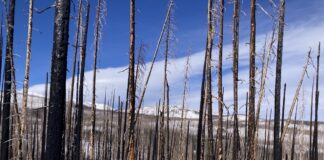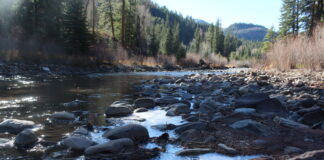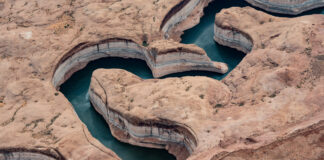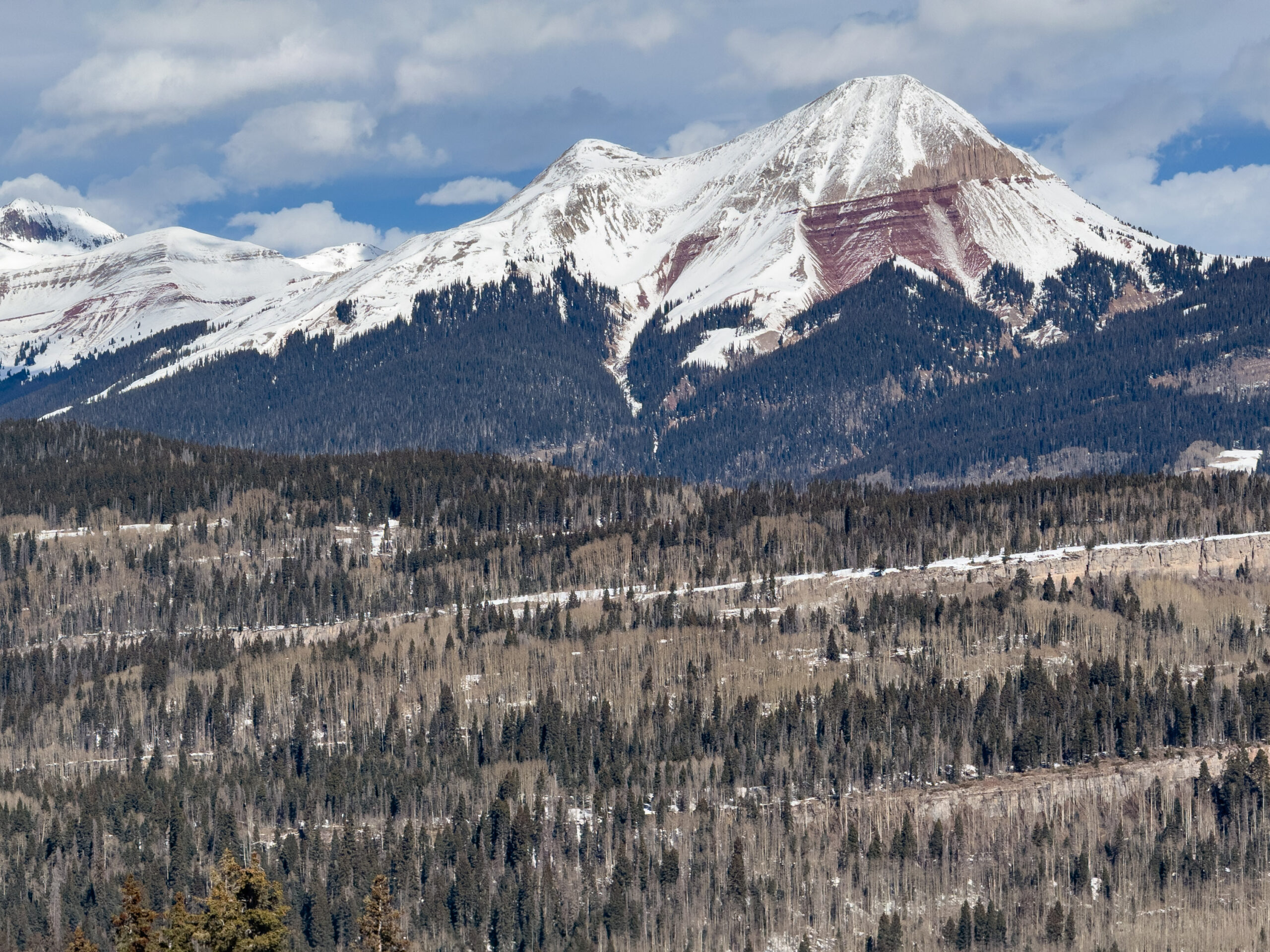
In recent years, scientists and water managers have started using the term “snow drought” to describe meager snowpacks in the American West.
A snow drought can come about in two main ways. A “dry” snow drought happens when not enough snow falls, leading to a diminished snowpack. A “warm” snow drought occurs when precipitation is near or above normal, but higher temperatures cause raindrops to fall instead of snowflakes, or when warm weather causes the snowpack to shrink rapidly.
Because a lack of snow has such profound implications for the West’s water supply, wildfire risk, recreational activities and ecosystem health, the federal government now regularly tracks the severity of snow drought across the region.
The reports rely on data from hundreds of SNOTEL stations—a network of automated sensors that use “snow pillows” to weigh the snowpack and calculate its water content—but federal budget cuts may hamper that system going forward.
To learn more about snow droughts, I recently spoke with one of the authors of those reports: Dan McEvoy, regional climatologist at the Western Regional Climate Center and the Desert Research Institute.
The Q&A below contains excerpts from my conversation with McEvoy, edited for clarity and brevity.

What is a snow drought? How is it defined?
Snow drought, in its simplest form, is just a snowpack deficit, or less snow than there should be for a given time and place, and it all is relative to that local place, wherever it might be.
This concept of snow drought is not new. There’s been a connection for a long time in the Western U.S. between snow and water and drought. But I think what is new is (that) the term snow drought was not really used commonly for a while, up until maybe six, seven years ago, when the research really picked up.
I will say there’s not really a single agreed-upon definition of what a snow drought is. If you look in the literature, there have been several different ways to define it.
Some studies will use April 1st snowpack or the peak snowpack and look at the anomaly during that time. Other work that I’ve contributed to took a different viewpoint and brought up this idea that we should be looking at snow drought daily as it evolves throughout the season, so tracking snow droughts from the beginning of the season to the end of the season through time. And so, in that sense, you could have an early-season snow drought and come out of it in the middle of the year, or the opposite: start off well and then go into a snow drought later in the year.
Something fairly common to use in terms of defining snow drought is a percentile-based method—where does the snowpack value fall in the historical distribution? And this is common in other definitions of drought, particularly the U.S. Drought Monitor uses a percentile threshold. So, for example, anything below the 20th percentile would be considered in a snow drought, and then there’s varying categories.
I guess I should step back and say that the variable that is the most common thing with a snow drought is the snow water equivalent (SWE), which is the amount of water that is in the snowpack at any given time.
Is it a problem or a challenge that different researchers are using different definitions?
I don’t think it’s a problem. I think we’ve seen this in other areas of drought, especially. I don’t know if you’ve heard of the term “flash drought,” but that’s another one that’s a bit older in terms of the research that’s been done, where there was never really a single agreed-upon definition. And I think that’s because the research is still ongoing to fully understand what a snow drought is and what it means.
It is good to have an agreed-upon definition if it comes down to using it for something like operational monitoring or a trigger for a drought emergency or a water shortage or something like that. But I think what we’re seeing in the literature is that the varying definitions are trying to get at different aspects of snow drought. And so I think it’s a good thing in a way. Perhaps down the road a bit, there might be a more agreed-upon singular definition, but it’s been very interesting to see how different research groups are trying to look at snow drought.
What are the practical implications of a snow drought? Who and what is affected?
I think the clearest connection with snow drought is related to water supply in the Western U.S. Snow drought is less snow than you should have, and our snowpack provides the majority of our freshwater surface water supply in the Western U.S., and so very often snow drought years are associated with lower-than-average runoff into streams and reservoirs, and then that can lead to further drought development in the summer months. In those snow drought updates, we try to pinpoint any specific impacts.
I think the research community is trying to unpack what a lot of these other impacts are. One that I’m interested in is in a snow drought year, you’ll often have a shorter snow season and the snow will melt out earlier than it would in an average year. And so that leaves the landscape and the ground and the vegetation exposed longer, when it would normally be covered in snow longer. And so this gets to the soils drying out quicker, the vegetation either greening up earlier and then drying out earlier, or just drying out quicker, and connecting that to wildfire danger impacts later in the summer. I think there’s a general consensus on the agreement that lower snow tends to increase fire danger in the summer, but there hasn’t been extensive work really getting into the weeds on that.
Another question that has come up that there haven’t been a lot of answers to is the more ecological impacts related to snow drought. I guess vegetation is one of those, but things like animals that depend on snow cover—that hibernate or depend on that snow cover for protection and insulation—and kind of understanding more about the ecological impacts related to snow droughts. That’s also something I’m interested in that I don’t think there’s a good answer to. So there’s some known impacts and I think still quite a few unknown impacts related to snow droughts.
We’ve seen all of these federal cutbacks in terms of monitoring and science agencies. Is that affecting your ability to monitor the snow drought?
The short answer is not right now, not immediately, but there’s a lot of concern. The biggest one is around cuts to NRCS [Natural Resources Conservation Service], which have already happened in some places. They’re the ones that install and maintain the SNOTEL network. The stations themselves aren’t going to just completely disappear. No one’s going to go out there and remove them. Of course, that would require staff to even do that. But the concern is that every single one of those gets at least maintenance once a year, if not twice a year by these NRCS staff. And that maintenance is what keeps the data high quality, making sure the stations are calibrated, functioning properly.
The other aspect is (that) the NRCS (does) manual QC [quality control] of the data. So people at the various offices actually look on a daily basis at the data streams coming in. They have an automated QC process, but they know that doesn’t catch everything, and so they actually have people going through these data streams, because the data transmits at hourly timescales and they actually look through that to make sure the daily values that show up are accurate. There’s people on a daily basis doing that data QC, and so a big concern is that we will see degradation of the instrumentation and the quality of the measurements as well as the data streams and the QC, basically leading to less reliable and less accurate snow measurements. So that’s a big concern. I haven’t seen an immediate impact yet, but we know that there have already been big losses at NRCS. The maintenance season is the summer, after the snow melts and they can get out there, so we may not see those impacts until the start of next winter when we go to start looking at the snow data again.
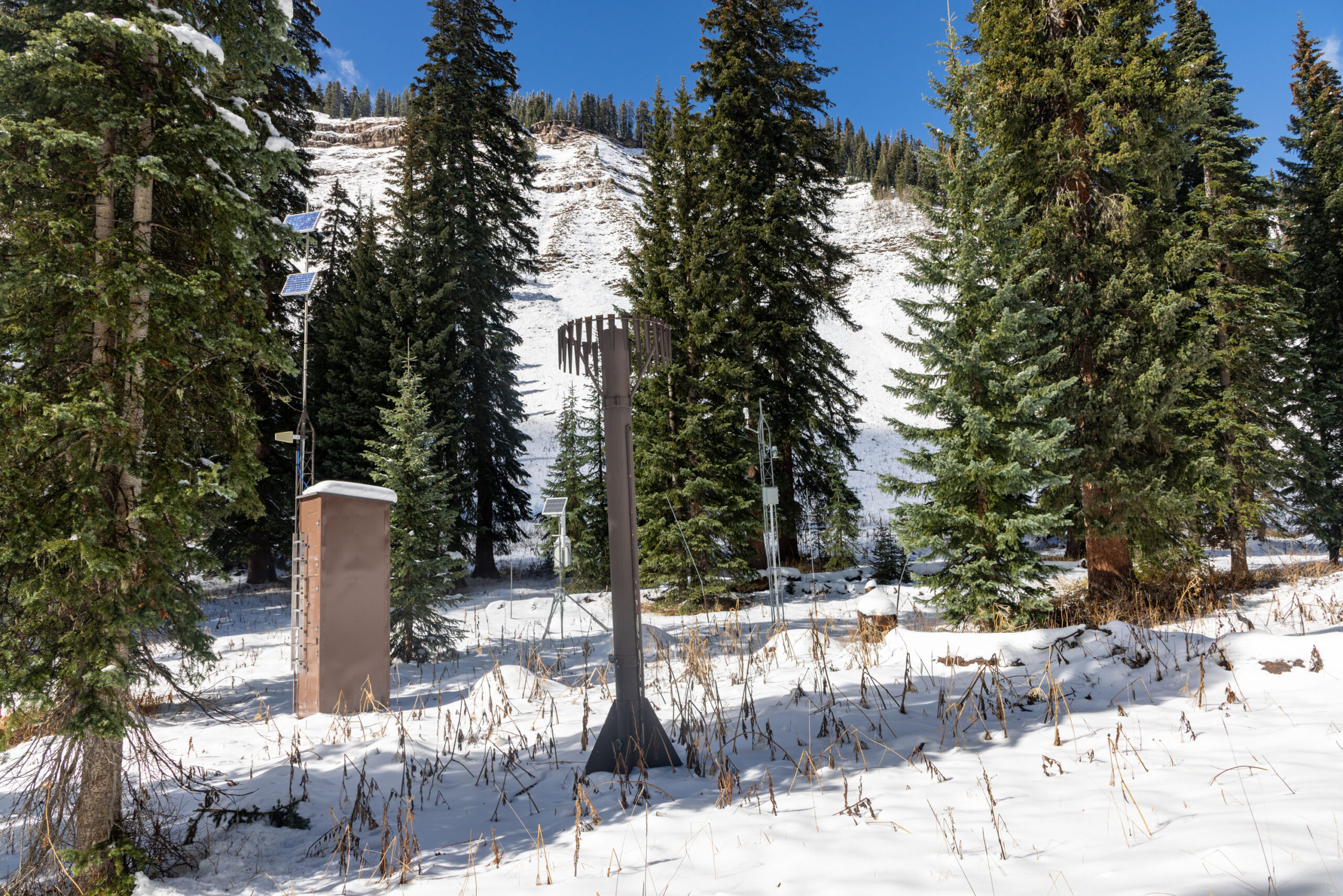
What is the connection between snow droughts and climate change?
There’s a general consensus and there’s good literature showing that since 1950, overall, the snowpack in the Western U.S. has been declining—more so in some places than others. That’s primarily due to warming and climate change. And so just that alone suggests that we will continue to see more frequent snow droughts, because again, a snow drought is less snow than you normally would have at any given time. There has been some research showing future projections that go out to the end of the century. Adrienne Marshall has a really nice paper that shows the peak SWE is projected to continue to decline, and there’s a much higher likelihood of seeing two snow drought years in a row.
(See my 2024 Q&A with Marshall on snow deluges, which are the opposite of snow droughts. McEvoy also cited an influential 2021 paper with an ominous title—“A low-to-no snow future and its impacts on water resources in the western United States”—that projected steep snowpack declines due to climate change.)
If we kind of continue on this warming path that we’re on, the snowpack is likely to continue to decline. That includes more rain and less snow in the mountains. So that would mean probably more warm snow droughts as opposed to just dry snow droughts as annual and water-year precipitation trends aren’t necessarily changing all that much, depending on where you are. And so a lot of that decline is going to be due to warming temperatures and more rain.
“Relative to today’s climate, I think there’s definitely an expectation of seeing more snow droughts in the future.”
What about predicting snow droughts? Are there early-warning systems or are there ways to look ahead to know that one is coming or building?
I think explicitly predicting snow droughts is still not being done right now. An early-warning system gets to kind of the elements of what we’re doing with the snow drought updates. It’s kind of staying on top of tracking it throughout the season, so water users or land managers aren’t just caught off guard when you get to midseason or late season and realize that the snowpack’s much lower than it should be.
Long-range and seasonal temperature and precipitation forecasts are commonly looked at, although once you get beyond about two weeks, there’s not a whole lot of reliability there. And so I think it really is still a huge challenge in trying to predict the snow drought even at the start of a season.



